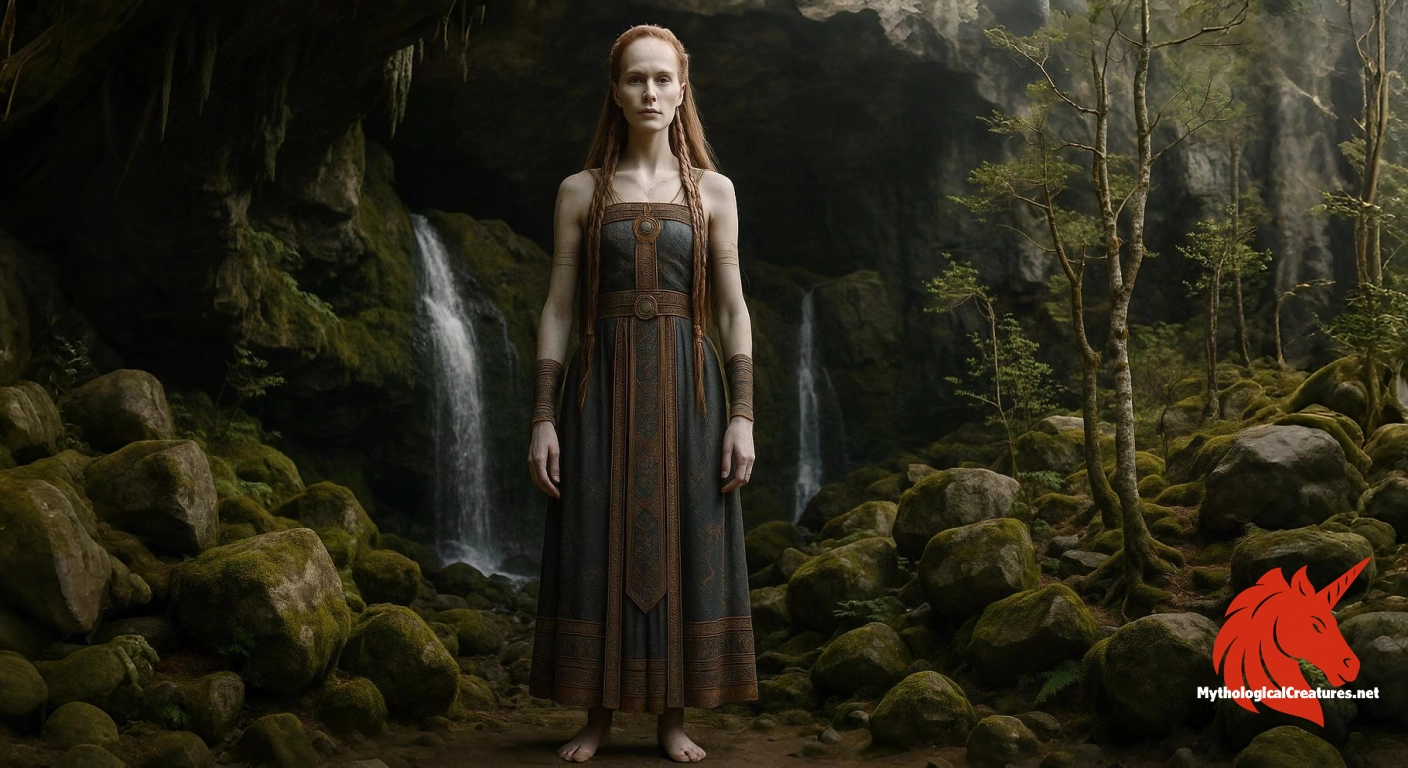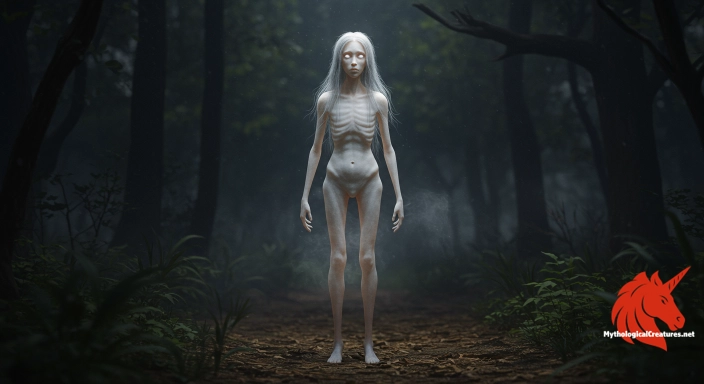Gunnlöð: Gunnlöð is a jötunn and giantess from Norse mythology known for guarding the mead of poetry.

Gunnlöð
Gunnlöð - Gunnlöð plays a central role in the myth that explains the origin of poetic inspiration in Norse culture, safeguarding a treasure that confers wisdom and artistic power.
Origins & First Encounters
Gunnlöd emerges from the mists of Norse myth as a striking figure whose very existence challenges the boundaries between beauty and danger. Born of the giant lineage and known as the daughter of Suttungr, she embodies the complex interplay of power and seduction that characterises many Norse legends. Her myth is interwoven with the fabled mead of poetry, a symbol of divine inspiration and the enigmatic forces of creative expression. The earliest attestations of her tale are found amid the vibrant narratives of pre-Christian Scandinavia, where oral traditions lent her a multifaceted role. In these accounts, she is not merely a guardian, but also a catalyst in the transformation of wisdom into mortal ingenuity. Her presence within the mythic landscape mirrors the Norse preoccupation with fate, honour, and the unpredictable nature of power. Through the centuries, she has inspired both admiration and caution, highlighting the perilous yet alluring nature of knowledge. Her story underscores the intrinsic link between the pursuit of poetic insight and the sacrifices required to attain it. The enduring appeal of her myth lies in its ability to encapsulate the dynamism of ancient belief systems while challenging listeners to contemplate the true cost of great wisdom.
Source Texts & Tale Variants
The narrative of Gunnlöd is preserved in a tapestry of sources that include seminal texts like the Prose Edda, where her part in the saga of the mead of poetry is both pivotal and enigmatic. Different manuscript traditions offer varied renditions of her encounter with those who seek the sacred beverage, blending elements of seduction and treachery. The texts, although concise, provide a window into the complex dynamics between the gods, jötnar, and the mortal realm. Variations in the recounting of her myth reflect both regional influences and the mutable nature of oral tradition. Over time, storytellers adapted her character to suit local tastes, infusing the legend with nuances that resonated with the evolving cultural milieu. Some versions stress her loyalty to her father, while others hint at a more independent spirit driven by her own ambitions. The intermingling of poetic skill and cunning in her narrative is a testament to the rich tradition of myth-making in the Norse world. These primary sources, though fragmented, continue to inspire modern interpretations and scholarly debates. Each retelling adds layers to our understanding of how myth and memory combine to preserve ancient wisdom. Thus, the stories of Gunnlöd remain a vibrant part of the enduring tradition of Norse epic narratives.
Form & Powers
Gunnlöd is often envisioned with an imposing yet irresistible physical presence, reflecting the typical traits associated with the jötnar of Norse lore. Her features blend the stark, rugged beauty of the natural world with an almost otherworldly allure that hints at her divine connections. Descriptions suggest that she possesses a tall, graceful stature with a strength that belies her delicate public demeanour. Her hair, flowing like streams of dark silk, is said to frame a face that combines both the intensity of a storm and the quiet mystery of twilight. Portrayals often reveal her eyes as deep and penetrating, echoing the ancient wisdom hidden within the mists of time. The artistic imagination has decorated her form with an array of natural elements—hints of stone, hints of foliage—symbolising her inherent link to the primordial world. At times, her attire is envisioned as both functional and ornate, merging the utilitarian with the ceremonial to reflect her dual role as guardian and seductress. Even in the sparse details available, these characteristics contribute to a portrait of a being who is as formidable as she is bewitching. The aura that surrounds her is one of magnetic intensity, a confluence of beauty and primal might that has captivated audiences for centuries. In every artistic interpretation, her depiction speaks to the eternal theme of the sublime and the dangerous, a hallmark of mythic narrative.
Regional Faces
Regional interpretations of Gunnlöd reveal a fascinating diversity in her portrayal, reflecting the varied cultural landscapes of the Norse world. In Icelandic sagas, she is sometimes depicted with an emphasis on preternatural seduction and a delicate balance between allure and threat. Scandinavian traditions, on the other hand, frequently focus on her formidable role as the keeper of a divine resource, underscoring the tensions between loyalty and defiance. Local storytellers imbued her character with region-specific symbols, such as the cycles of nature, to mirror the environmental contexts familiar to their audiences. These adaptations not only highlight her function as a guardian but also stress the inevitable clash between mortal endeavour and sacred power. In some versions, her allure is heightened by romanticised elements that emphasise her enigmatic beauty and mystique. Other regional variants cast her as a more tragic figure, whose destiny is intertwined with the inexorable forces of fate and sacrifice. The interplay between these diverse depictions underscores the dynamic nature of oral tradition, where local values shape and reshape a myth over time. As such, her character continues to reflect the polyvalent cultural identity of the broader Norse mythos. Ultimately, the regional variations of Gunnlöd’s story serve as a rich canvas for exploring the theme of power, possession, and poetic inspiration.
Cultural Parallels
The figure of Gunnlöd can be compared with a host of guardian beings found across different mythological traditions, each charged with protecting divine treasures or secret knowledge. Her role as the sentinel of the mead of poetry finds echoes in the guardianship stories of Greek and Celtic legends, where coveted substances or locales are fiercely protected. In Greek lore, for instance, certain nymphs and river deities assume the role of safeguarding the ambrosial gifts of the gods, a motif that resonates with the essential themes of transformation and temptation. Similarly, Celtic myths often feature otherworldly custodians who combine beauty, danger, and wisdom in their very essence. These parallels underscore a widespread mythological pattern: the introduction of a trial or barrier in the quest for transcendent knowledge. Gunnlöd’s narrative, with its emphasis on seduction and peril, also aligns with the archetypal image of the siren or enchantress prevalent in Mediterranean tales, albeit with a distinctly Norse sensibility. The comparative study of these figures reveals how different cultures have approached the mystique of hidden, potent forces through similar narrative archetypes. Such cross-cultural connections enrich our understanding of how ancient societies perceived the boundaries between the human and the divine. By juxtaposing these diverse guardians, one can appreciate the universal themes of risk, reward, and the transformative pursuit of insight echoed in their stories. The enduring legacy of these motifs highlights the fundamental human intrigue with the barriers guarding sacred truths.
Legacy & Modern Evolution
Over the ages, the story of Gunnlöd has evolved from a fragmentary myth into a powerful symbol of creative potential and the enigmatic nature of inspiration. Early Norse sources cast her as a formidable figure, a guardian whose presence was both a boon and a bane to those who dared to seek the divine mead. As the narrative journeyed through time, her role has gradually shifted from a simple antagonist to a multifaceted emblem of the struggle between human endeavour and otherworldly forces. In modern reinterpretations, her image has been embraced by artists and writers alike, who see her as an embodiment of the profound and often perilous relationship between creativity and power. Contemporary adaptations in literature, visual arts, and even popular culture often reimagine her not just as a seductress, but as a complex figure who challenges the very nature of inspiration. The naming of Saturn’s moon after her testifies to her enduring appeal, linking celestial wonder with ancient myth. Neo-pagan and revivalist movements have also rediscovered her myth, attributing to her symbolic resonance a call to reconnect with forgotten traditions and elemental wisdom. Film and digital media have further cemented her legacy, presenting her as a timeless icon whose allure continues to inspire debate and reinterpretation. Her story, rich with symbolism and layered meanings, continues to resonate with a modern audience, reflecting enduring preoccupations with the cost of wisdom and the price of beauty. In every era, Gunnlöd remains a potent reminder of the transformative powers hidden within myth, ever urging us to explore the mysterious borderlands between the human and the divine.
Interesting Fact
Saturn’s moon Gunnlod is named in her honour, underscoring the lasting impact of her myth on both literature and modern astronomy.
Quick Creature Info
Origin:
Features:
Associations:
Our Mythic Legendary Rating:

Also Sometimes Known As:
Habitat:
Supernatural Powers:
Physical Attributes:
Abilities:
Behavior:
Lore:
References
Discover Another Mythical Legend You May Not Have Heard Of?
Uncover the mysteries of ancient folklore and expand your knowledge of legendary beings from cultures around the world.
Dare to Meet the Gwisin....
Mythical Disclaimer: The images and data on this site are derived from various historical and literary sources, but we have found that many myths often have multiple versions and interpretations across references, sometimes contradictory. As a result, these creature depictions are artistic interpretations—imaginative blends of folklore, legend, and a dash of AI guesswork. Because creature descriptions vary widely, our illustrations and accompanying information represent our best effort to honor mythology while bridging creative gaps. Enjoy these interpretations—just remember, we've done our best to respect the stories and validate available data, but in the realm of mythology, details often shift, imagination leads the way, and nothing is ever set in stone!
Curated by the Mythological Creatures Team (rev. May 2025)
